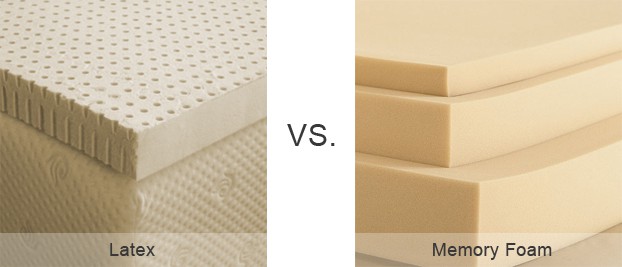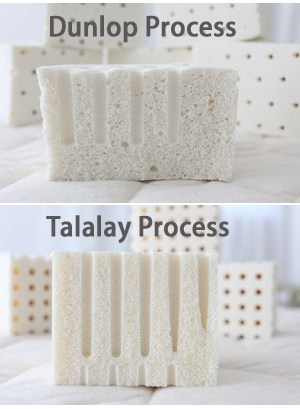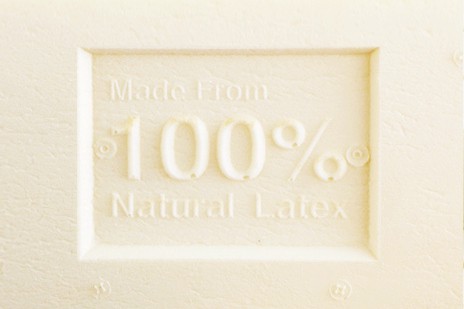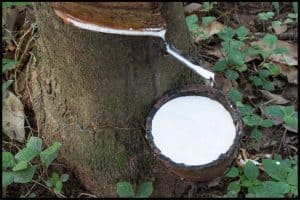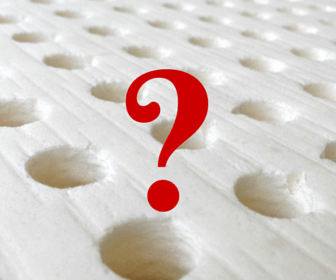A common question we get here at San Diego Mattress Makers, is what type of mattress should I get, a latex mattress or memory foam? Usually the person who asks that question is tired of their innerspring mattress and wants to try something different. A simple answer to that question is it depends… There are many variables to factor when choosing which type will be right for you. In this post we’ll examine each sleeping surface and hopefully equip you on making a wise decision.
The 6 factors we’ll go over when comparing latex vs memory will be:
- Comfort
- Back Support
- Durability
- Motion Separation
- Temperature factor
- Price
Let’s first start with Latex Mattresses.
I assume you’re somewhat familiar with what a latex mattress is at this point, if your not too familiar with what a latex mattress is I recommend reading our post on What Is A Latex Mattress first to give you an overview.
Comfort and Feel
When people are looking for a new mattress comfort is usually the first thing they look for. Memory foam and latex mattresses each have a very distinct and unique feel. Latex mattresses have a more springy buoyant feel, while memory foam has a more dense and slow sinking feel. Your comfort preference is purely personal, however latex mattress do offer more variations of feels than memory foam does. If you are more accustomed to or prefer a traditional mattress feel but want to get away from a spring mattress, then latex will give you that option because you can add the quilted top to give you a more traditional feel without losing any of the benefits of latex. Memory foam mattresses do not give you that option. You can’t add any other comfort layers or padding on the top layer because you will then lose the benefit and feel of memory foam. So if you like the slow-response sinking in feeling that memory foam offers memory foam would be your best choice. If you’re looking for more variation on feel then we suggest to choose latex.
Edge- Latex
Back Support
Another important aspect in shopping for a mattress is back support. Like comfort, back support is a very personal thing. There are no two bodies that are exactly alike. There are so many different body types and different needs. Some people carry their weight more on top while others carry their weight near the hips and mid section. What you want to look for in a mattress is to make sure that the mattress is going to conform to your body and keep your spine in alignment.
Memory foam mattresses do a great job of conforming to your body’s curves. With memory foam you can be sure that there will be no empty gaps or spaces between you and the mattress. Now keeping your back straight without sinking in too much is a different matter. Not all memory foam beds are created equal when it comes to back support. When looking for a memory foam mattress, make sure there is a solid support layer underneath the memory foam so you’re not sinking in too deep. You want to make sure the support layer is a high density foam that is at least 2.5lb in density. Any thing less than that would compromise your support long term. Another thing to be aware of when trying out memory foam is, you want the memory foam to be at minimum 4lb of density, anything less than 4lb of density will begin to feel that your hips and lower back sink in much lower than the rest of your body.
Latex mattresses also do a great job with conforming to your body. The big advantage of latex mattresses is that they while it conforms to your body’s curves it also distributes your weight evenly and keeps your spine in alignment. Overall latex is a more solid and consistent material, thus preventing you from sinking in too deep into the mattress.
The major difference that latex mattresses have over memory foam mattresses when it comes to back support, is that with memory foam mattresses, the memory foam itself is not providing you the support, it is the poly foam (polyurethane foam) support layer under the memory foam where you get the support. And over time poly foam does tend to break down faster than latex foam.
Edge- Latex
Durability
A mattress that lasts at least 8-15 years is a good indicator of a quality mattress. The durability is one of the most important factors. Latex mattresses have a great reputation of durability. Years ago when I used to deliver mattresses, I remember taking old latex mattresses out of customers houses that were 30-40 years old, and noticed that the integrity of the mattress was not compromised. The mattress wasn’t saggy or lumpy and the only reason they were replacing their mattress was because they either wanted something softer or more firm.
I’ve recently found a video showing a 50 year old latex mattress still in very good shape.
In looking for a latex mattress, going with an all natural or natural and synthetic blend is the way to go in terms of durability. There is less expensive latex out there that has fillers put in to bring down the cost, and even though it feels like latex you lose the overall support and durability compared to an all latex mattress.There are also different qualities of memory foam mattresses available and one of the biggest factors that determine it’s durability is the density. As I said earlier you want to make sure the memory foam you’re getting is at least 4 lb density. Anything less than that you run the risk of premature body impressions.
Overall there are way too many variables with memory foam to give you solid data on it’s durability. It is very hit or miss with memory foam to determine it’s durability because China now is a major importer of memory foam products. Latex on the other hand is much more consistent and has been proven to out last any other mattress type.
Edge – Latex
Motion Separation
We’ve all seen the commercials with the wine glass and the person jumping up and down on a mattress. This is a great demonstration of the motion separation from Tempurpedic. When I first saw this demo I was a bit skeptical but when I used to work as a salesperson at a popular mattress store in San Diego I had a couple walk in with a bottle of wine and actually asked to do the wine test. I was brand new at the time and didn’t know what to do so I let them do it with a towel underneath the wine of course. And to my surprise the test actually did work. The wine bottle did not tip over.
Latex mattresses however are the next best thing when it comes to motion transfer. Because the latex absorbs the energy of any one moving, you will also have a hard time feeling the other person as they get in and out of bed. However, since it does have a more springy, bouncy feel you can feel the person move a bit more than you would on a memory foam. So with out a doubt memory foam mattresses definitely give you the best motion separation from the other person in bed.
Edge- Memory Foam
Temperature factor
Heat can be a make or break when getting a good night sleep. In my years of selling memory foam beds and in specific Tempurpedic, the biggest complaint we would get was that the mattress sleep hot. Memory foam by it’s nature is designed to respond to the temperature around it. If the room is cold the mattress will be very firm, if the room is warm the mattress will be much softer. Tempurpedic got its name from “temperature” because it not only responded to your weight but also your body temperature.
The past year or so several different cooling foams and gels have been added to mattresses to try to get them to sleep cooler. From the experience I have had with other customers, sales people from other mattress stores, and even experiencing it myself, the new cooling technology has been a little improvement but not enough to make a significant difference.
Latex mattresses have a more open cell structure as well as the have holes going through the mattress which naturally allow the mattress to breathe and allow for air to circulate throughout the mattress. So overall in mattress breathability we would have to give the edge to latex.
Edge- Latex
Price
Perhaps the most important factor for some shoppers is the price of the mattress. The biggest drawback for people in going with latex mattresses is the price. A queen size mattress that is all latex will run you at least around the $1200 mark. And that is on the low end. However there are some latex blended products with filler foam that I’ve seen for under $600. But I would advise against going too cheap on latex because you then lose all the advantages latex that we talked about. So if you’re looking for a quality latex mattress look to spend at least $1200-$2000.
Memory foam on the other hand has quite a few more options. The choices for different memory foam mattresses has increased exponentially over the last 5 years. Now it’s no longer just Tempurpedic and a few no names to choose from. You literally have hundreds of different memory foam brands to sort through, and because of that the price has gone down dramatically. I’ve seen memory foam mattresses for under $300 recently which makes it appealing to anybody on a budget. So if price is your biggest factor then memory foam might be a better choice.
Edge – Memory foam
And The Verdict Is?…
If you want to count the wins and losses above then go for it. However these factors don’t all carry the same weight for some people. For some back support is the number one factor and to others it may be motion separation. But if you are looking for more of a diverse feel with great support that will last you a heck of a long time then latex will be the clear cut winner. If you’re looking to save some money and want great motion separation then maybe a memory foam mattress might be right for you.
The best advice I can provide is go into a store and try both. Your body is the best judge and if the store has a lenient return or exchange policy then great, don’t sweat the decision. Try them both out and go with the one that fits your body best. We would love to hear about your experience and which one you decided. So shoot us an email or respond in the comments and let us know!
